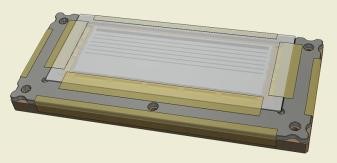Lead Organisation: Teledyne e2v
Project Lead: David Barry
Partners: Surrey Satellite Technology Limited (SSTL) & The Open University

This project will produce a prototype instrument to demonstrate a novel imaging system incorporating Time Delay and Integration (TDI) CMOS image sensor technology. This technology allows for small pixels on an inherently radiation-hard, low power and highly integrated platform.
Presently, there does not exist in the market a low cost payload with the performance required to meet the growing demands of the commercial ‘New Space’ EO market (very high resolution, good quality image, low mass and low recurrent cost).
The existing CCD solutions will not work for new platforms especially with the demand for ever higher resolution, so the market will definitely change. TDI CMOS will give a much lower cost system with dramatically reduced power consumption and weight enabling new space applications that are still being created.
Teledyne e2v, SSTL and the OU have developed considerable expertise in imaging design, manufacturing and testing for space applications. This consortium is collaborating to establish the UK as a truly integrated technical lead for image sensors, focal planes, instruments and satellites in the highly competitive and rapidly growing application of high and medium resolution EO.
The main activities being carried out by the consortium are:
- Teledyne e2v are developing the prototype TDI CMOS sensor technology platform, including associated packaging, back-thinning and AR coating.
- The OU are responsible for the characterisation of the sensor performance including radiation testing and are working with SSTL on the design and build of a set of drive electronics suitable for mounting in the telescope focal plane.
- SSTL will evaluate the performance of the focal plane in a prototype telescope.
This new imaging sensor technology, combined with SSTL’s experience in building very high resolutions imagers, will provide a new entry level for customers looking to take advantage of a sub-metre ground sampling grid using a smaller imager system than would normally be required. The smaller system will also lend itself well for constellation building as it will be easier to build batches simultaneously in comparison to the traditional systems.

The UK is currently in a good position and this development will enable the UK to maintain its market lead in a key enabling technology within a rapidly growing market sector. It is estimated that it will enable the capture of market share with a significant ROI and contribute to helping the UK achieve its ambition of growing its share of the global space market to 10% by 2030. Around 90% of this business will be generated by exports thus helping the UK to achieve the goal of reaching £25bn a year in exports in the same period.
